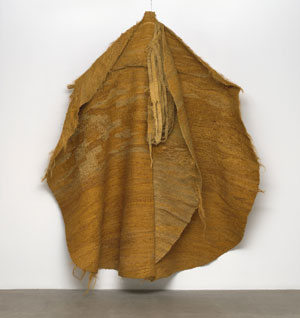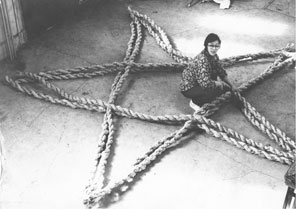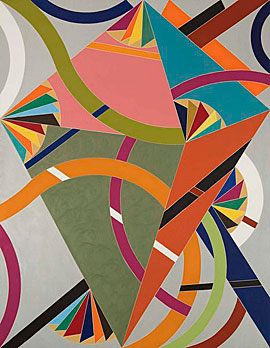Making Space in Abstraction
John Haberin New York City
Making Space, Kazuko Miyamoto, and William T. Williams
Maybe MoMA is finally getting the point. It has begun focusing on its collection, which got short shrift in its 2004 expansion, and on women, which got short shrift before and after. It has done so with special exhibitions to illuminate movements in modern art. And now "Making Space" headlines not a period in history, but women in abstract art. For another act of recovery, but in the galleries, Kazuko Miyamoto worked with one of the leading Minimalists on the way to abstract painting and sculpture all her own.
While MoMA pays only token attention to African Americans, take heart: while women were making history, William T. Williams was ripping through many of the same years.  In 1969, fresh out of grad school and a newcomer to New York, Williams entered the collection of the Museum of Modern Art. MoMA must have thought it knew what it got. (Hey, a watchword of late Modernism was "what you see is what you get.") It did not, for already the African American artist was challenging the mainstream.
In 1969, fresh out of grad school and a newcomer to New York, Williams entered the collection of the Museum of Modern Art. MoMA must have thought it knew what it got. (Hey, a watchword of late Modernism was "what you see is what you get.") It did not, for already the African American artist was challenging the mainstream.
Getting the point
"Making Space" does not try to pick winners in the contemporary scene—although women like Kate Shepherd have done plenty to drive the resurgence of painting. MoMA has been picking winners for a long time, but that is starting to look more suspect in a hot market with a short memory. Rather, it tackles the glory years of postwar abstraction and Minimalism. With "Women of Abstract Expressionism" in Denver, Carmen Herrera and "Labyrinth of Forms" at the Whitney, "Perseverance", or Emily Mason and Sonia Gechtoff in the galleries, other institutions are getting the point, too. The display of the collection quite generally will be changing as well—and the changes are rubbing off on men.
The show calls attention to past practices as well, although not going all the way back to Sophie Taeuber-Arp. When critics object to a paucity of women in museums, they almost always mean MoMA. Recently women in abstract art have seemed to be everywhere, but at this museum mostly as Marina Abramovic staring off into space. The good news is that more than third of this show consists of fairly recent acquisitions. The bad news is what that says about the last forty years or more, after paintings by Lee Krasner, Joan Mitchell, Helen Frankenthaler, and Agnes Martin as well as Krasner in collage shaped a generation's understanding of postwar art. With shows like this, they could shape a new generation's understanding now.
Not that MoMA was ever out of the picture. It says as much with the exhibition title, which recalls the standard history of abstraction as formalism, as well as the need to make room for women. It says so, too, in mentioning exhibitions going back to 1951. It cites "Abstraction in Photography" when it comes to Barbara Morgan and Gertrude Altschul, "The Responsive Eye" when it comes to Bridget Riley and Op Art, and "Wall Hangings" when it comes to Sheila Hicks and Anni Albers—who had served as acting director of the weaving workshop at the Bauhaus. It opens with big gestures in red, blue, and green by Grace Hartigan, whose work toured the country in "New American Painting" starting in 1956. She was the sole woman present.
Coming late to the game has its advantages at that. Like prior shows of "Dadaglobe" and "The Revolutionary Impulse," it allows the curators, Starr Figura and Sarah Hermanson Meister, to bring history up to date. They devote nearly a room to Latin American art, including Altschul, Lygia Clark, Lygia Pape, and Gego. They incorporate design with ceramics by Lucie Rie and again with tapestry in a room for "Fiber and Line," including a grand cape of rumpled sisal by Magdalena Abakanowicz. They can even distance themselves from formalism by calling the last room "Eccentric Abstraction"—for such figures as Lee Bontecou, Jay DeFeo, Louise Bourgeois, Lynda Benglis, and Eva Hesse, if not Claire Falkenstein. The very first room bows to globalism with Etel Adnan, born in Lebanon, and to African Americans, with Alma Thomas.
A revisionist history is bound to bring surprises, even with work acquired long ago. That first room counters the epic scale of Abstract Expressionism with collage by Anne Ryan and Janet Sobel, perhaps the first drip painter. The show leaves out Hesse's large work in favor of hanging paper-mâché and cord, created at an abandoned German textile factory. I already hear cries to move all this immediately to the regular galleries, displacing as many men as possible, to get a revisionist history going there, too. That would be a mistake. This is not a zero-sum game at the expense of men who changed the rules—and it is not another round of puffery and pop stars.
Does MoMA have a distinct vision of women in art? Maybe or maybe not, and either can be the point of giving them their due. One can argue that all along, as with Mitchell or Krasner's Gaea, they have rooted abstraction in both subjectivity and nature. One can again argue for riffs on craft, such as polyurethane Belly-Cushions by Alina Szapocznikow. One can also argue for women as outsiders, including Jews who escaped Europe—with Szapocznikow a Holocaust survivor like Si Lewen. Male immigrants like Arshile Gorky would understand.
Massive or spare?
Was Minimalism massive or spare? Was it an art of big boxes and steel plates—or bare lines and empty rooms? How about none of the above? For Kazuko Miyamoto, it could hold the wall or spin out across a gallery. Dating from a time of industrial materials, it could insist on the handmade, the irregular, the repetitive, and the imagination. Work from the late 1960s through 1980 helps recover a woman in abstraction for today.
Born in Tokyo, Miyamoto came to New York in 1964 to be a painter. She studied at the Art Students League, already past its prime as a nurturer of Abstract Expressionism. Like others then, she retained broad brushwork, while stripping down to simpler geometries. She also began to engage the wall. Maroon on black from 1969 resembles brickwork, like paintings by Sean Scully, but as Progression of Rectangles. From that point on, she treats the art object as a solid, but also as a source of optical activity and motion.
Massive and spare went together in those days, much as work by Carl Andre kept to the floor under its own weight. When Frank Stella turned the wood of his stretchers sideways, so that it comes further out from the wall, he insisted that painting can bear weight, too. When Richard Serra flung lead, he had begun to spill out into space as well,  but one had sure better get out of his way. When Richard Tuttle bisected a gallery in thread or Sol LeWitt drew a dizzying array of lines, they were making wall paintings. Rosalind E. Krauss included all these artists in a legendary show of "Line as Language," at Princeton University in 1974, along with Mel Bochner, Robert Morris, and Dorothea Rockburne. Miyamoto should have one seeing the line as much as the wall or the language.
but one had sure better get out of his way. When Richard Tuttle bisected a gallery in thread or Sol LeWitt drew a dizzying array of lines, they were making wall paintings. Rosalind E. Krauss included all these artists in a legendary show of "Line as Language," at Princeton University in 1974, along with Mel Bochner, Robert Morris, and Dorothea Rockburne. Miyamoto should have one seeing the line as much as the wall or the language.
She had already discovered a concern for line in LeWitt. They had studios in the same building in 1968, along with Adrian Piper, and met outside during a fire alarm. (She still lives on the Lower East Side at age seventy-five, and she exhibited nearby at Invisible-Exports in 2014.) As a studio assistant, she worked on his wall paintings and open cubes. She began to incorporate parallel marks into her drawings, including grids of dabbed ink and plus signs, too. They may allude to traditional Japanese calligraphy and the game of Go as well.
Galleries and museums have been looking for parallels to Minimalism in other nations, such as Grupo Frente in Brazil and Mono-ha in Japan. They have also been seeing these movements as sites of personal expression and gendered identity. (Hélio Oiticica, a gay from Brazil, spent the 1970s in New York.) Gender enters Miyamoto's art with a break from the wall—and, not in the show, studies after the inherited form of the kimono. She described dense arrays of string nailed to the studio wall and floor, from 1974 and 1978, as female and male, and do not go thinking of the "purity" of white as female or blackness as male. The show includes recreations of both.
They build on her drawings, but they take their full shape only as one walks past their more than a thousand nails. They also nearly dissolve into light. Paper ladders hang instead from above. They recall Joan Miró or a rope ladder to the moon. The gallery accompanies the show with a Japanese poet's tribute to Miyamoto, as if she lived only in memory. If her imagery is any indication, she has already moved on.
From Billie Holiday to Proust
Those first broad bands of conflicting color by William T. Williams, separated by thin outlines, look straight out of Frank Stella—or do they? Stella had introduced his Protractor paintings just two years before, and they are still among his biggest, brashest, and most recognizable works. Seemingly everyone then wanted to be the next great white hope, and no doubt MoMA was looking for him, but Williams? Hardly. His bands run every which way, straightening out, fanning out, snaking out, or overlapping. Tall, narrow paintings like Harlem Angels from 1968 seem cut off by the edge of the canvas, as if glimpsed through a door.
Sometimes what you see is not what you get. Those thin outlines are white, not bare canvas, because Williams does not derive his image, like a proper formalist, from the art object, but rather from experience. Shows have given pride of place to black abstract artists—like Jack Whitten (in addition to Whitten in sculpture), whose tiles of dark acrylic just ran elsewhere. And the door-like paintings are six feet tall but barely forty inches across, like a painter standing tall. Their freewheeling style and flirting with illusion also recall white artists who did not quite play by the rules as well, like Al Held and Jack Tworkov. They may still, though, have other stories to tell.
Born in 1942, Williams remembers quilting in rural North Carolina, much like Mary Lee Bendolph amd Gee's Bend quilting, and his next series took him to near monochrome built from crosshatching. (Its metallic colors, while still acrylic, return in the show's most recent work.) He also thinks of jazz with a title like Strange Fruit, after the Billie Holiday song about a lynching. He must think of race, too, in a series from the 1980s. Its colors build to a greater darkness, and the brushwork resolves into hands raised as if scraping against a wall in the throes of death. Paintings from 1988 to 2002 rely on a patchwork of rectangles, maybe an echo of wood siding. 
Better not, though, take anything too literally. Williams had his MFA from Yale and fell into a busy New York art scene. The one remaining past series, from the 1970s, divides canvas into just two or three areas, like early Brice Marden. Some paintings have Marden's muter tones as well, although deepened by contrasts between fields. Flat areas may lie alongside looser brushwork, richer colors, or more quilting. When it comes down to it, Williams is always setting approaches to art side by side, just as in deconstructing Stella. He calls one painting of hands A Note to Marcel Proust.
He does have at least one thing in common with Stella: each time he takes a series to its next step, it changes altogether. His twenty-eight paintings in Chelsea, like his appearance at the 2018 art fairs, start with his latest—in part to give the largest and squarest early paintings enough space in back. Paintings since 2007 fit comfortably by the entry. Their approach to Chinese calligraphy, unlike that of Tong Yang-Tze in Asia, with dry and broken marks in yellow or white over closely matched fields of blue, almost demands close quarters. Yet the reverse chronology also insists that he did not begin in New York or quit in 1971.
Not every gallery can transform a tight show into a serious retrospective like this one, and not every series has equal weight. The best do the most to explore a vocabulary for painting, a bit like formalism after all. The early band paintings still do it best, like palettes or color wheels flying across the room. The paintings from the 1970s do it more subtly. The paintings spanning the 1990s do it, too, with a return to bright colors and distinct brushwork in every patch. One can see why, by their dates, each took Williams more than a decade.

"Making Space: Women Artists and Postwar Abstraction" ran at The Museum of Modern Art through August 13, 2017, Kazuko Miyamoto at Zürcher through October 22, William T. Williams at Michael Rosenfeld through June 3, and Jack Whitten at Hauser & Wirth through April 8. Miyamoto returned to New York in 2022 at the same gallery, through July 25, and Japan Society Gallery, where an abridged retrospective ran through July 10, including the kimonos.




